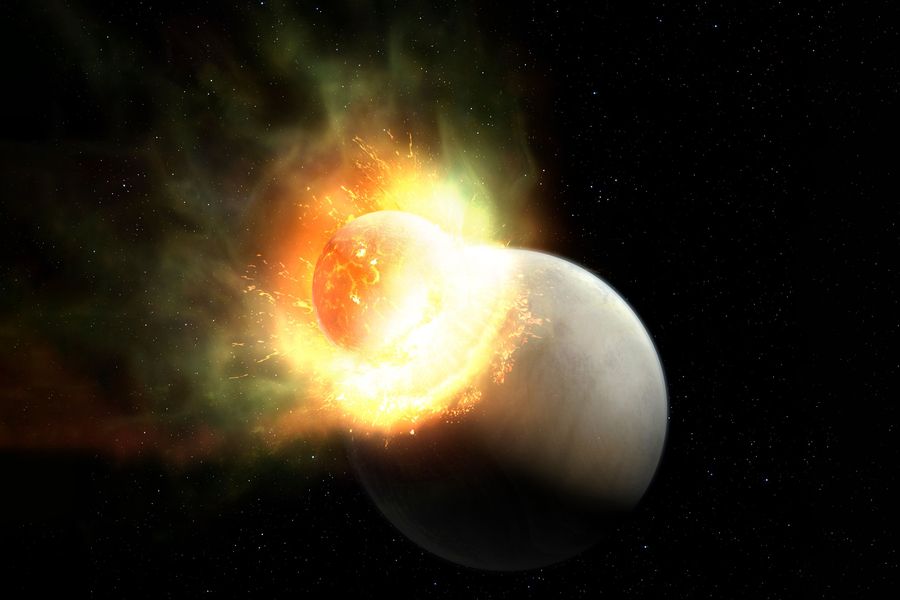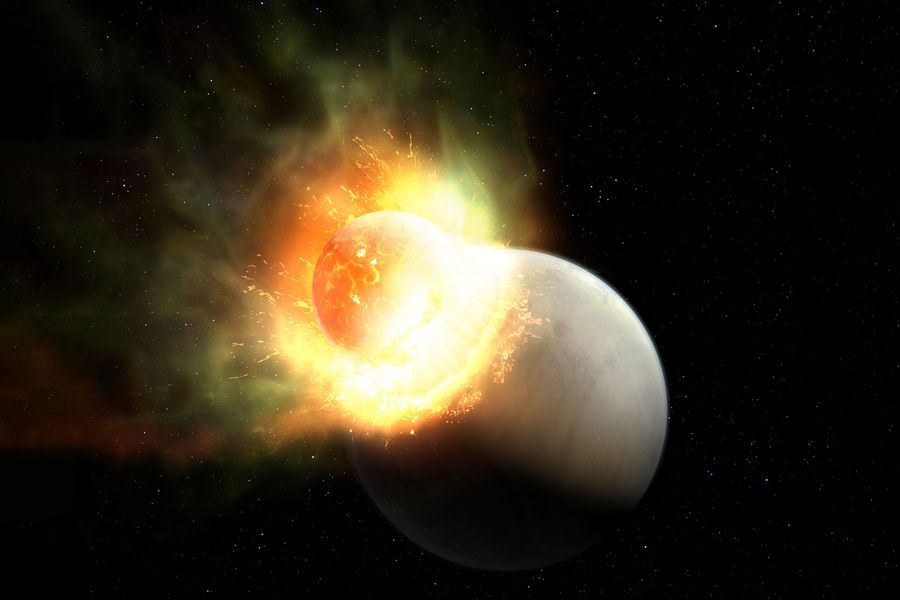
Astronomers may have for the first time detected evidence that a distant planet had its atmosphere partially blown away by a giant impact, a new study finds.
Scientists think newborn planetary systems generally experience titanic growing pains as infant planets-in-the-making, known as protoplanets, slam together and fuse to form progressively larger planets.
“Our own solar system shows abundant evidence of giant impacts,” study lead author Tajana Schneiderman, an astronomer at the Massachusetts Institute of Technology, told Space.com.
For example, previous research suggested the Earth and moon are the products of such giant impacts in the early solar system. However, “despite this, there hasn’t been much observational evidence for giant impacts elsewhere,” Schneiderman added.
Related: Hidden exoplanets may trigger auroras on distant stars
Now Schneiderman and her colleagues have discovered signs of a giant planetary smashup about 95 light-years from Earth. The cosmic impact — around the 23-million-year-old star HD 172555, in the constellation Pavo, the peacock — likely blew away part of the atmosphere off a world, they noted.
“We’ve detected a stripped atmosphere for the first time,” Schneiderman said.
The star HD 172555 previously drew the attention of scientists because of the unusual nature of the dust surrounding it. Prior work found this stardust possessed grains much finer than astronomers would expect for a typical disk of debris surrounding a star. This dust is also loaded with a large amount of unusual minerals, such as obsidian and black glassy tektites, which require powerful heat to form. Previous research suggested one possible explanation for such dust was two worlds colliding — a crash involving speeds of more than 22,000 mph (36,000 kph).
In the new study, astronomers investigated what gas surrounding the star might reveal about its history. They analyzed data from the Atacama Large Millimeter Array (ALMA) in Chile, focusing on signs of carbon monoxide.
“When people want to study gas in debris disks, carbon monoxide is typically the brightest, and thus the easiest to find,” Schneiderman said in a statement. “So, we looked at the carbon monoxide data for HD 172555 again because it was an interesting system.”
The scientists were able to detect carbon monoxide around the star. When they measured its abundance, they found the gas around HD 172555 was equivalent in amount to 20% of the carbon monoxide found in Venus’ hellish atmosphere. They also saw that it was circling in large amounts surprisingly near the star at about 7.5 astronomical units (AU), or 7.5 times the average distance between Earth and the sun.
The presence of carbon monoxide so close to a star is a mystery because the molecule is normally vulnerable to photodissociation, a process in which photons (or particles of light) break down and destroy the chemical. There is typically very little carbon monoxide near stars, leading the researchers to analyze various scenarios to explain its presence around HD 172555.
The scientists quickly ruled out a scenario in which the carbon monoxide arose from the debris of a newly formed star. Prior work suggested carbon monoxide would scarcely last beyond the first 3 million years of a star’s life, much less HD 172555’s age of 23 million years.
When the researchers examined another scenario in which the carbon monoxide was emitted by many icy comets streaking in from a far-out asteroid belt, similar to the solar system’s Kuiper Belt, they found it could not explain the minerals seen in the dust.
The scenario the astronomers think best explains all the data is a giant impact between protoplanets — “a larger progenitor and a smaller impactor,” Schneiderman said. “The energies involved are huge — the impact will result in parts of the bodies getting melted, so some material from both will likely remain in place, while some material is going to get thrown off the progenitor.”
“When it comes to the atmosphere, some of the atmosphere is going to be pushed out by the impactor hitting the solid body, some of the atmosphere is going to be pushed out from the rest of the planet as the shock wave travels through the atmosphere, and some might be stripped over a longer period of time,” Schneiderman added. “The impact is going to deliver energy to the atmosphere, which results in the atmosphere heating up. As it heats up, it becomes easier for the atmosphere to get removed.”
In planetary systems as young as HD 172555’s, astronomers expect giant impacts are quite common, Schneiderman said. When it comes to a giant impact explaining the carbon monoxide detected around that star, she noted the timescales work out, the age works out, and the constraints on the composition and shapes of materials seen around that star work out.
Related stories:
“A giant impact is the best explanation for the system features,” Schneiderman said.
The researchers estimated the carbon monoxide came from a giant impact at least 200,000 years ago, recent enough for the star to not have enough time to completely destroy the gas. Based on the abundance of the gas, they suggest the collision took place between two massive bodies, likely protoplanets comparable in size to Earth.
“I think a really critical implication is that the gas that is released in the aftermath of a giant impact can last for a long time, and it can affect the way the system evolves long-term,” Schneiderman said. “It would be very exciting to get additional observations of this system with the current ALMA configuration — the upgrades that have occurred since 2012, when the measurements were originally taken, would enable us to understand the system in greater detail.”
In addition, “I think it would also be worth looking at other young systems,” Schneiderman said. “The detection of carbon monoxide in this system suggests that carbon monoxide might be brighter than dust, so a detection of carbon monoxide post-impact might be more observable than the dust is. I think targeting carbon monoxide gas might give us an opportunity to understand the occurrence statistics of giant impacts more broadly.”
The scientists detailed their findings online Oct. 20 in the journal Nature.
Follow us on Twitter @Spacedotcom and on Facebook.



